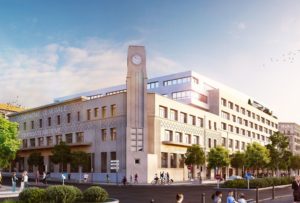A “City of innovation” (CISAM) in Marseille to help laboratories and start-ups
In the former headquarters of the SNCM, Aix-Marseille University is opening a vast space dedicated to the development of research and innovation. Report on the occasion of the “Monde” O21 event, organised in Marseille on 5 February.

The former headquarters of the SNCM shipping company is sumptuous building. Three Art Deco floors, a roof terrace and a view over the port of Marseille. This is a prestigious setting worthy of the ambition of the new City of innovation and knowledge Aix-Marseille (CISAM). It is a unique structure in the French university landscape, designed and financed by Aix-Marseille University (AMU). President Yvon Berland explains that the aim is to “assert the position of the university and its researchers as players in innovation and economic development in their territory.” CISAM will be officially inaugurated on 13 March, but its three floors – an entirely renovated space of 2,800 m2 – have already been home to nearly 80 people since the end of August 2018.
On the ground floor of the Castel – the building’s code name – M accelerator of Aix-Marseille-Provence Metropolis and French Tech office, a government-approved support scheme for digital start-ups, face the 450 m2 managed by AMU. The first floor is occupied by Zebox, a business incubator and accelerator conceived and run by the shipping company CMA-CGM, whose headquarters are nearby. On the second floor, amidst a decor of wood and greenery, L’Occitane has opened Obratori, its “start-up studio”, dedicated to innovations in health, well-being and cosmetics.
“A totemic place”
“The CISAM is dedicated to development and innovation. Valorisation is the translation of applied research into economic outlets. Innovation, on the other hand, comes from fundamental research. In both fields, we thought we were the most legitimate to have a driving role because it is our laboratories that invent,” explains Eric Berton, vice-president of AMU, who has been steering CISAM from the outset. “The idea was to create a totemic place to bring together the structures working to promote the work of researchers and to offer a single point of access to industrialists wishing to submit their needs to us,” he continues.
The objective has been achieved. Even if the pathway is not yet clearly signposted, an entrepreneur receives, on entering the Castel, the promise of being accompanied throughout his project. In the immaculate open space of the AMU, offices and skills that were previously fragmented are now combined: the Development Department, which collects the 100 to 130 invention declarations made by researchers each year; the South-East Technology Transfer Acceleration Company (SATT), which guides researchers and entrepreneurs through to exploitation licences; Protisvalor, which manages contracts between laboratories and industrialists…
“We will organise for the industrialist the right meeting with a researcher motivated to work with the private sector, in the right field,” summarises Charlie Barla, innovation officer at the South-East Technology Transfer Acceleration Company and professor at AMU.
Banks, but also representatives of institutional incubators and competitiveness clusters in the region complete the course. Finally, the Carnot Star Institute, which federates eight laboratories specialising in sport, well-being and health, which generated 3 million euros in private contracts in 2017, shares the premises. “We will organise the right meeting for the industrialist with a researcher who is motivated to work with the private sector in the right field,” explains Charlie Barla, innovation officer at the SATT and professor at AMU. Until now, contracting with a laboratory could take a year and a half. In the long term, we hope to achieve this in six months. A partnership with Provence Promotion, the economic promotion agency of the metropolis, makes it possible to offer the Castel scheme to industrialists from elsewhere. Visits from Danone, but also from British investors in search of post-Brexit horizons, are scheduled.
“Very high-level research”
AMU’s “totemic spot” and its location in the heart of Euroméditerranée, a public operation that is transforming Marseille’s inner port, have aroused the interest of other partners. By deciding to each occupy a floor of the Castel, Obratori and Zebox have expanded the project and have increased the opportunities for collaboration for researchers in the area. “There is a very high level of research in this area, particularly in artificial intelligence, which is of great interest to us,” confirms Matthieu Somekh who, before managing Zebox, was in charge of the entrepreneurship and innovation centre at the Ecole Polytechnique. On the top floor, Amaury Godron, managing director of Obratori, says the exact same thing. “We have identified eighteen research centres of interest to us in the AMU area. This is a wealth that had previously escaped us, even though our main factory is located in Manosque, an hour-drive away from here,” he says with surprise.
The presence of these private partners and of the metropolis as public partner, also allows AMU to lighten the burden of its investment. Eric Berton estimates the loss at 70,000 euros for the launch year. “But we are already making the most of our investment,” says Yvon Berland, who points out that the Provence-Alpes-Côte d’Azur region is also supporting the project to the tune of 150,000 euros.

By Gilles Rof – Published on 03 february 2019 at 09h00
Link to the full article (in french) : Le Monde.fr
[/vc_column_text][/vc_column][/vc_row]



